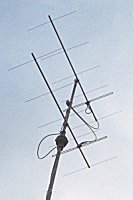6-Element yagi for 144 MHz
Introduction
I designed this antenna in 1995. I wanted a horizontal antenna which has nice characteristics for contest usage. The side lobs are minimized, the beam width is quite large while it has a reasonable gain and front/rear ratio.
Design
The design is based on the DL6WU principle. This is a popular design, and dipoles are available ready-made so no need to construct one yourself. Although DL6WU is normally used for large antennas (above 2 WL), it is still working very nicely on 1 WL. Which some small modifications I finally designed antenna with the following specifications for 144.3 MHz:
- Gain: 10.9 dBi / 8.8 dBd
- Front-rear ratio: 15.0 dB
- 3dB electrical beam width: 50 degrees
The design has been performed using yagimax2 software and practical tests. I created several prototypes before I found out the correct measurements.
| Element | Length in cm | Distance to reflector in cm | Diameter in cm |
| Reflector | 101.6 | 0 | 0.33 |
| Dipole | 99.0 | 38.2 | 0.80 |
| Director 1 | 93.5 | 54.6 | 0.33 |
| Director 2 | 92.5 | 91.8 | 0.33 |
| Director 3 | 91.3 | 136.4 | 0.33 |
| Director 4 | 90.3 | 188.6 | 0.33 |
Construction
The construction is simple. The folded dipole is available at the VERON Servicebureau (article nr. 2002). The other elements are made from AlMg3 welding bars. They are placed through the boom (aluminium, 2×2 cm), fixed/isolated by aquarium tube. See the pictures for some details. For matching I use a half-wave coaxial cable, which acts as a 1-to-4 balun.
For fixating the elements there’s a simple trick to know. The holes should be drilled with a precise radius. For the aquarium tube I found I used 5.3mm, but the exact radius might differ a little depending on the brand of this tube. After drilling the hole, put a small piece of tube in it. Now put some water on the element. This water should contain some chalk. The water will enable you to easily push the element through the tube. When dried (this may take a while) the chalk will remain and fixate the element.
Results
I made hundreds of QSO’s with these antennas. I mostly used 2 stacked yagis, which was performing greatly. It would be a very nice antenne for setting up large antenna arrays with a clean radiation pattern. Unfortunately I’m unable to setup such arrays (yet?). With my IC-271E (25 watts) and 2 yagi’s at 12m AGL (open field) I was able to work over 800 km without special conditions. The design was also used by a major dutch contest group, where they used 4 groups of 4 stacked yagis, pointed to 4 fixed directions. The majority number of QSO’s was made using these antenna groups, for real DX and weak signals they used stacked longyagi’s on a rotor to get some extra dB’s…
Please mail me your experiences with this antenna!
![[image]](https://www.pa3hcm.nl/wp-content/uploads/2013/12/enh-logo1.jpg)

![[image]](https://www.pa3hcm.nl/wp-content/uploads/2014/01/homebrewn-yagi-1.jpg)
![[image]](https://www.pa3hcm.nl/wp-content/uploads/2014/01/homebrewn-yagi-2.jpg)
![[image]](https://www.pa3hcm.nl/wp-content/uploads/2014/01/homebrewn-yagi-3.jpg)
![[image]](https://www.pa3hcm.nl/wp-content/uploads/2014/01/homebrewn-yagi-4.jpg)